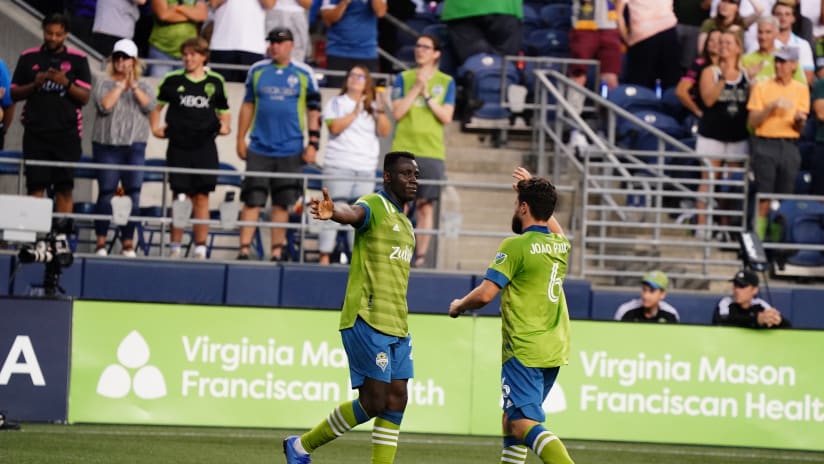Since the start of the 2019 MLS season, one word keeps popping up in interviews with Seattle Sounders players and coaches: tempo.
“We would like to [play on the front foot] every game,” midfielder Cristian Roldan said ahead the Chicago Fire match, a game the Sounders won 4-2. “Not just the goals, but the tempo of play, the pressing, the ability to get back defensively. I think the commitment level was there from the get-go [against Colorado].”
There are two ways to dictate tempo in soccer: on the ball and off the ball.
When the Sounders have the ball, they manage the rhythm through intricate, sustained possession, overloading key areas of the field and stringing together dizzying passing combinations. Once they’ve wrestled control of the match, the Rave Green become more effective at upping the tempo as they catch opponents off-guard and blitz them in transition.
Pressing schemes
Off the ball, the Sounders have set tempo with their defensive schemes. Make no mistake, an imperious back line has been the bedrock of the Sounders since Head Coach Brian Schmetzer took the helm midway through 2016. But this year, they’ve made it difficult for opponents to set a rhythm on the ball by disrupting opponent’s possession through pressing traps, re-pressing once the Sounders turn the ball over and attacking players tracking back defensively.
In the modern game, pressing has become all the rage, especially in Germany, as teams look to set the tempo on both sides of the ball.
The thinking goes that, if you can win the ball higher up the field, you’re not only closer to the opposition goal, but you’re also attacking a team that is spread out and disorganized, incapable of getting into a solid defensive shape as you bare down on goal.
So, how are the Sounders' attackers adjusting to these new tasks? Just three games into the season, the front four have combined for eight interceptions and nine tackles. But the more telling stat is possession recoveries.
While the likes of Jordan Morris, Nicolás Lodeiro, Raúl Ruidíaz and Víctor Rodríguez can’t be considered hard-nosed, defensive-minded players, they’re incredibly quick and very effective at harassing opponents on the ball, shuttling them into blind alleys and then sending a second and even third defender. Through three matches, the front four have combined for 58 recoveries.
The the team is not a breakneck, high-pressing team like Liverpool, for instance, the Sounders have become very effective at scouting opponents and setting pressing traps based on their tendencies in possession.
In the above clip, the Sounders set a wide trap, with Rodriguez, Brad Smith and Gustav Svensson ushering Chicago’s possession to the flanks. Once there, Smith drops off and denies a ball down the line and Lodeiro man-marks Dax McCarty out of the play, baiting Diego Campos into passing the ball to Przemysław Frankowski. As soon the pass is played, Svensson reads the defensive cues brilliantly, accelerating and closing down Frankowski, regaining possession in the opponent’s half. With the Fire spread out from their buildout phase — notice the incredibly high line from the Fire’s back four — Lodeiro picks his head up and clips into space that Morris dispatches for the second goal.
Disrupting from the front
Part of dictating tempo when defending is breaking up the rhythm of the opposition. You have to wrestle control of proceedings by stifling the other team’s possession, denying them any opportunity of getting a foothold in the match.
“In the game against Colorado, I thought we started off the first 10 minutes of the second half a little bit dysfunctional because of all the fouls and the chippiness of the game,” Schmetzer said on last week’s episode of “Winging it with Zakuani.” “And then Colorado had a little spell of getting possession. I can show you on the film 4-5 times where Raul chased back a nicked the ball off a guy. Those small moments, if you’re a midfielder a or a defender who’s been working [hard], when you see your forward run back and nicking a ball, those are beautiful things to see."
Tailor-made tactics
One thing Schmetzer has shown through his tenure is an understanding of how to tailor his defensive scheme to the opponent. Against Colorado, he pinched the wingers inside to make sure his 4-2-3-1 wasn’t overrun by the Rapids’ four-man diamond midfield.
Against Chicago, he had Lodeiro man-marking the closest central midfielder while Ruidíaz hovered between the center backs, essentially daring the center backs to facilitate possession by stepping into midfield and playing line-breaking passes.
This accomplished two key goals: unbalancing the Fire’s shape, thus making them vulnerable to transition moments, and restricting McCarty’s and Bastian Schweinsteiger’s influence on the match. This was so effective that Schweinsteiger started dropping deeper and deeper, prompting Fire Head Coach Veljko Paunović to switch to a 3-5-2.
Seattle’s wide players have done and admirable job tracking back and contributing defensively. Morris has shown a defensive acumen that has surprised many supporters, as his responsibilities differ drastically from when he was a No. 9. More specifically, his ability to pick his opponent’s pocket and then quickly exploit space out wide has made the Sounders even more lethal in transition.





